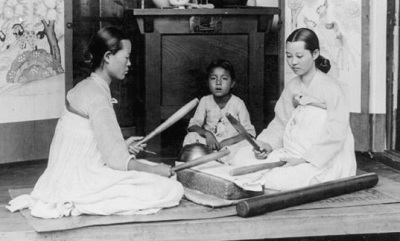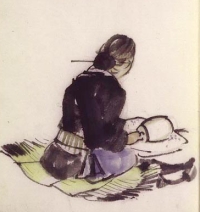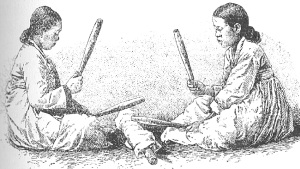-
History of:
- Resources about:
- More:
- Baby walkers
- Bakehouses
- Bed warmers
- Beer, ale mullers
- Besoms, broom-making
- Box, cabinet, and press beds
- Butter crocks, coolers
- Candle snuffers, tallow
- Clothes horses, airers
- Cooking on a peat fire
- Drying grounds
- Enamel cookware
- Fireplaces
- Irons for frills & ruffles
- Knitting sheaths, belts
- Laundry starch
- Log cabin beds
- Lye and chamber-lye
- Mangles
- Marseilles quilts
- Medieval beds
- Rag rugs
- Rushlights, dips & nips
- Straw mattresses
- Sugar cutters - nips & tongs
- Tablecloths
- Tinderboxes
- Washing bats and beetles
- Washing dollies
- List of all articles
Subscribe to RSS feed or get email updates.
Tadumi "pressing clothes".....the sound of tadumi is nostalgically evocative of Korean life in both town and country.
Pratt and Rutt, Korea: A Historical and Cultural Dictionary, 1999
The song of the ironing sticks sounded throughout the Inner Court. On the narrow veranda outside her apartment, the [children's mother] and one of their aunts sat facing each other. Their white-stockinged feet were tucked comfortably under their full white skirts. Their hands flew deftly up and down, their ironing sticks pounding the strips of fine white grass linen folded upon the low oblong ironing stone between them.
Frances Carpenter, Tales of a Korean Grandmother, 1973
Traditional "ironing" in Korea and Japan
 In Korea the drumming of traditional ironing sticks was traditionally called a joyful sound. Even though
it didn't please all ears, it was a symbol of a secure home life. In Japan the beating
of a single mallet pounding fabric smooth was associated with melancholy - in poetry
at least. In Korea two women knelt on the floor, facing each other across a smoothing
stone or tatumi-tol,
a pangmangi club in each hand, beating out a rhythm on the cloth.
This kind of "ironing" looks more solitary in Japanese art (see right), where a
woman kneels alone before a
fulling block or kinuta and hammers with a single mallet.
In Korea the drumming of traditional ironing sticks was traditionally called a joyful sound. Even though
it didn't please all ears, it was a symbol of a secure home life. In Japan the beating
of a single mallet pounding fabric smooth was associated with melancholy - in poetry
at least. In Korea two women knelt on the floor, facing each other across a smoothing
stone or tatumi-tol,
a pangmangi club in each hand, beating out a rhythm on the cloth.
This kind of "ironing" looks more solitary in Japanese art (see right), where a
woman kneels alone before a
fulling block or kinuta and hammers with a single mallet.
 When Victorian missionaries and other Western travellers observed Korean customs
they were struck by the sound echoing through their evenings. People from both East
and West describe it as musical: percussion with different resonances depending
on the individual blocks and sticks.
When Victorian missionaries and other Western travellers observed Korean customs
they were struck by the sound echoing through their evenings. People from both East
and West describe it as musical: percussion with different resonances depending
on the individual blocks and sticks.
Everywhere on the banks of rivers women were eternally pounding laundry; you could almost feel the threads parting company with the terrific beating - washing with stones and ironing with sticks.
Margaret Sanger, Autobiography, 1938
Some 19th and 20th century Westerners showed an ignorance of their own cultural history. Beating washing clean and pressing it smooth without hot metal was the custom in parts of Europe into the 20th century. Most travel writers presumably came from households with big tubs of hot soapy water, and a collection of flat irons heating on a stove.
A Korean tatumi-tol granite or marble block was a valued family possession, perhaps with carved decoration: especially on the underside, so the design was visible when it was stored upside down to protect the smooth top. In both Japan and Korea cloth might also be wound on rollers for pounding, just as laundered cloth was wound on rollers or "pins" in Northern Europe before being pressed with mangle boards sliding back and forth.
....his wife washes and pommels his clothes. I say "pommels, " for ironing is an unknown art in Korea....the calico is stretched on a wooden block, and then with a flat block of wood in each hand the woman pounds it for hours. After sunset all Seoul rings with the dactylic tap-tap-tap, tap-tap-tap of these domestic voices of the night ....
Henry Norman, The Peoples and Politics of the Far East, 1895
Ironing with hot metal was far from unknown. The Chinese had had their own pan-irons long before European blacksmiths made anything similar, and these were also used in 19th-century Korea. (As in this picture of two women using a hot iron.) But pounding and flattening was the traditional way of tackling laundry. The Korean custom for pressing a fine robe was to unpick the seams, press each piece thoroughly, and then sew everything back together. The fabric was folded and re-folded on the tatumi-tol, beaten and pounded until it was perfectly smooth.
 To an outsider, it looks as if using ironing sticks could be a satisfying kind of hard work. It requires
skillful co-ordination and partnership, and it was sometimes said to be a way for
women to let off steam.
To an outsider, it looks as if using ironing sticks could be a satisfying kind of hard work. It requires
skillful co-ordination and partnership, and it was sometimes said to be a way for
women to let off steam.
The Japanese fulling-block and Korean smoothing-stone, like so many other tools used in pressing cloth, had their uses in manufacturing new cloth as well as in maintaining laundered fabric. (Fulling involves beating the fibres to make the cloth thicker and/or softer.)
 4 July 2007 (updated May 2012)
4 July 2007 (updated May 2012)
Listen to the sound of Korean ironing sticks - just above the picture of two women sitting at the ironing block.
>>>>More on ironing and smoothing techniques
You may like our new sister site Home Things Past where you'll find articles about antiques, vintage kitchen stuff, crafts, and other things to do with home life in the past. There's space for comments and discussion too. Please do take a look and add your thoughts. (Comments don't appear instantly.)
For sources please refer to the books page, and/or the excerpts quoted on the pages of this website, and note that many links lead to museum sites. Feel free to ask if you're looking for a specific reference - feedback is always welcome anyway. Unfortunately, it's not possible to help you with queries about prices or valuation.


